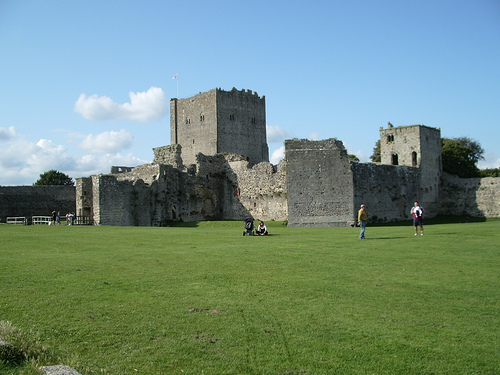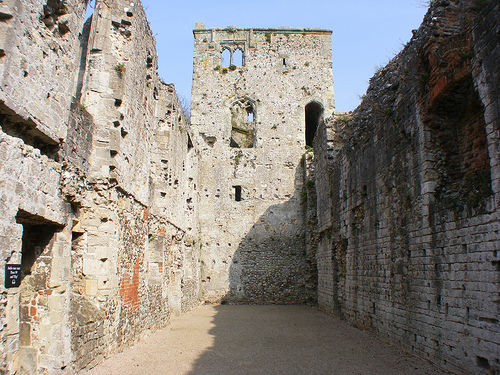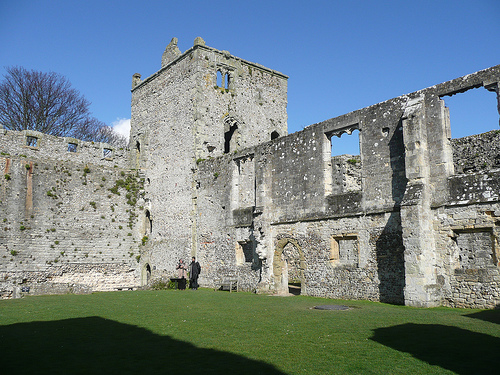

Location: Castle St., Porchester, Hampshire Map
Constructed: 11th century by William Maudit
Tel. 023 9237 8291
Open: daily
Closed: 1 Jan, 24- 26 Dec

Portchester Castle is a medieval castle incorporated into a former
Roman fort in Portchester, east of Fareham in Hampshire, England.
The fort ensemble is situated at the north end of Portsmouth
Harbour. The castle, which was probably built towards the end of the
11th century, belonged to a baron and was placed under royal control in
1154. The Crown controlled the castle for several centuries; it was the
preferred hunting lodge of King John the Landless. In 1216, Portchester
Castle was besieged and taken by the French, but shortly thereafter
returned permanently to English hands.
The castle occupies a
dominant position at the end of Portsmouth harbor and had its own
important harbor in medieval times. From there, troops led by English
kings embarked for a number of attacks against France. To guard against
a possible French attack in the first quarter of the 14th century,
Edward II invested £1100 in repairs and improvements to Portchester
Castle. A plot to overthrow Henry V was discovered and the conspirators
arrested at Portchester Castle. This event also occurs in William
Shakespeare's drama Henry V. Later the castle was also used as a prison.
Today Porchester Castle is a Scheduled Monument and has been listed
as a Grade I Historic Building by English Heritage. The castle has
belonged to the Southwick Estate since the 17th century but is managed
by English Heritage and is open to the public all year round. The Norman
parish church of St Mary's in the south-east corner of the property is
part of the Anglican Diocese of Portsmouth.

The Romans recognized the strategic importance of Portchester no later than the 3rd century AD, although it is not known exactly when this fort was built, but it is attributed to Marcus Aurelius Carausius, who had it built between 285 and 290 at the behest of Emperor Diocletian . It was part of the chain of fortresses on the Saxon coast (Litus saxonicum) and served as a defense against Germanic plunderers and immigrants from the mainland. Portchester was also believed to be a base for the Classis Britannica, the Roman fleet tasked with protecting the waters around Britain. Today it is the best preserved Roman fortress north of the Alps. Although Roman troops withdrew from Britain in the early 5th century, it is unlikely that the fort was abandoned as a result. After that, it was only used to a much lesser extent. A 10th-century hall building and tower have been discovered inside, suggesting that it served as a residence for high-ranking figures in the Anglo-Saxon period. In 904 Porchester came under the rule of King Edward the Elder and the fort was expanded into a burh to help defend the island from Viking attacks.
It is not certain when the castle was built, but it is believed to be
at the end of the 11th century. After the Norman conquest of England,
the lordship of Porchester was given to William Maudit, a companion of
William the Conqueror and a powerful magnate. It was probably he who had
Portchester Castle built. The form of this early castle is also
uncertain, but Maudit is credited with creating the central bailey in
the north-west corner of the castle. At that time, the fortifications
probably consisted of a wooden palisade and a moat, with the old stone
walls of the Roman fort serving as fortifications for the outer bailey.
William Maudit died around 1100 and his estates passed to his son,
Robert Maudit. He died in 1120 and a few years later the family estates
passed into the hands of William Pont de l'Arche by marriage to Robert
Maudit's daughter. Although the castle was not mentioned in a document
at the time, it was probably rebuilt in stone. Evidence of this is that
the masonry of the castle is similar to that of the parish church of St.
Mary, which was built in the outer bailey in the 1130s. The church was
created for Augustinian priory that Pont de l'Arche founded in 1128
within the castle walls. Other buildings were planned for the priory,
but no trace of them remained. As the monastic community moved to their
new site in Southwick between 1147 and 1150, these buildings are
believed to have never been completed.
William Pont de l'Arche
probably kept Portchester Castle until his death in 1148 and it is not
known who then inherited it. It may have fallen to William Maudit, a
descendant of the Maudit family, or to Henry Maudit, William de
l'Arche's son. The first explicit mention dates from 1153 and states
that Henry Plantagenet, the later English king Henry II, gave the castle
to Henry Maudit as a fief. Regardless, Henry took possession of
Portchester Castle when he came to the throne in 1154. From then on, the
castle remained in the hands of the crown for several centuries. More
records survive of the castle as a royal fortress than of the previous
period. Details of the condition and structure of Porchester Castle are
included in the pipe rolls. For example, from the fact that only small
sums of money were invested in the keep throughout its period in royal
hands, one concludes that it was mostly complete, and for the year 1183
these records show that there were royal apartments in addition to the
keep at the castle gave. Henry II regularly visited Porchester Castle
and the castle is mentioned in his dispute with Thomas Beckett. Here
King Henry met the Bishop of Évreux, who advocated for Thomas Beckett.
The castle also served as a prison for important people, such as B. the
Earl of Leicester. When Henry II's son, with the help of some leading
barons, rebelled against his father in the revolt of 1173-1174,
Porchester Castle was made ready for war. In order to be able to defend
the castle, it was equipped with catapults and a garrison headed by 10
knights, a number later increased to 20 knights.
King John was a
frequent visitor to Portchester Castle and was there when he heard of
the loss of Normandy in 1204. The Forest of Bere was close by, making
Portchester Castle a favorite retreat for the king. English troops also
made their way to France from Portchester when John was attempting to
retake Normandy from Philip Augustus, King of France, in 1205 and 1213.
Johann's trips to France ended in defeat. After John signed the Magna
Carta in 1215, he approached the Pope with a request for annulment. As a
result, his opponents were excommunicated in September. He besieged
Rochester Castle and the rebels turned to France for help. The barons
offered the English throne to Prince Louis, the eldest son of the French
king. Louis' attack was initially successful, taking London and
Winchester before Portchester Castle surrendered to his troops in June
1216. Johann Ohneland died on October 19, 1216 and nine days later his
eldest son became King Henry III. crowned. Louis' tide of war turned and
the English recaptured Portchester Castle in the spring of 1217. As a
result, there was a stalemate between Henry III. and Louis until English
victory at the Battle of Lincoln on May 20, 1217. After his supply lines
to France were severed in August 1217, Louis was forced to leave
England. Henry strove and recaptured Normandy, which his predecessor had
lost, until conditions in England forced him to abdicate in 1259. During
this period, military expeditions to France often departed from
Portchester Castle.
Little attention was paid to the
fortifications of the castle for most of this century, but towards the
end of the century a wooden tower was built to reinforce the eastern
part of the Roman wall. Fearing another French invasion during the reign
of Edward II (1307-1327), a garrison was placed at Portchester Castle.
Between 1320 and 1326 the Crown invested more than £1100 in the repair
and enlargement of Portchester Castle. The buildings of the main castle
were rebuilt and the outer gatehouse expanded. Despite the costly work
ordered by Edward II, an appraisal from 1335 found that many of the
castle's buildings were in a state of ruin and that the south wall of
the Roman fort had been damaged by the sea. Although he rarely stayed at
Portchester Castle, Edward III assembled. in June 1346 his army of
15,000 men there before launching an attack on France that ended in
victory at the Battle of Crecy. More work was done in the 1350s and
1360s; the residential buildings in the castle were rearranged and the
wall facing the sea was repaired. The royal bedchambers were built
between 1396 and 1399 and can still be seen today, albeit in a ruinous
state. They were built for King Richard II under master builder Walter
Walton.
In 1415, King Henry V had Portchester Castle prepared for
an attack on France that was part of the Hundred Years' War between the
two countries. While he was at Portchester Castle in July, a plot to
overthrow him, later called the Southampton Plot, was discovered. In the
castle he had the traitors imprisoned: Richard of Conisburgh, 1st Earl
of Cambridge, Henry Scrope, 3rd Baron Scrope of Masham, and Sir Thomas
Grey. The three men were executed in early August.
In the 15th
century the nearby town of Portsmouth, around 10 km away, developed into
a prominent commercial center and important port. It took over the role
of important military facility from Portchester and Portchester Castle
began to fall into disrepair. An assessment from 1441 called the castle
"rather ruinous and weak". Despite its condition, the castle was chosen
in 1445 as the site for the landing of Margaret of Anjou, wife of Henry
VI. The castle continued to crumble until the last decade of the 15th
century when efforts were made to restore the castle buildings. When
King Henry VIII and his Queen Anne Boleyn came to the castle in October
1535, it was the first time a reigning monarch had stayed there in over
a century. From October 1562 to June 1563, the English occupied the port
of Le Havre on France's north coast. During this period, the castle
served as a military hospital for soldiers injured in the conflict with
France. As relations with Spain deteriorated, Queen Elizabeth I had
Portchester Castle ready for war to forestall a Spanish invasion. In
1603 the castle was in a suitable condition for the queen to hold court
there. Sir Thomas Cornwallis became constable and had the buildings
along the east side of the main bailey remodeled. A royal appraisal of
1609 documents the improved condition of the castle and mentions that
the buildings that Cornwallis had remodeled now contain "four fine
bedchambers upstairs and as many offices downstairs".
The Crown relinquished control of the castle when King Charles I sold
it to Sir William Uvedale in 1632. Since then, Portchester Castle has
been passed down to his descendants, the Thistlethwaite family. The
castle saw no action during the English Civil War, although it was
briefly garrisoned by Parliamentarian Dragoons in 1644. A possible role
for castles at that time was that of a prison. From the late 17th
century this became Portchester Castle's most important function. In
1665, 500 prisoners of war from the Anglo-Dutch War (1665-1667) were
housed in the castle. Some of them lived in the church in the outer
bailey. They damaged the building by setting fire. The church was not
repaired again until 40 years later. From 1702 to 1712 the Crown leased
Portchester Castle from the Uvedales to house prisoners taken during the
War of the Spanish Succession. The first detailed descriptions of the
conditions of detention date back to the mid-18th century.
The
castle was last used as a prison in the 19th century, for over 7000
prisoners from the Napoleonic Wars. On Hospital Lane (formerly Seagates
Lane), which runs along the west side of the castle, was the prison
hospital, now a private residence known as Portchester House. Deceased
prisoners were often buried on the mudflats south of the castle, and the
occasional storm would wash away their remains.
Today Portchester Castle is mainly used for leisure activities: there are exhibitions in the main bailey. The castle is a popular destination for school trips, while the beach is used at high tide by anglers fishing for flounder and perch.
Local legend has it that Pontius Pilate was brought here in old age in a galley for a last resort.